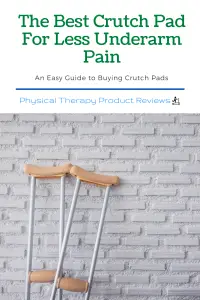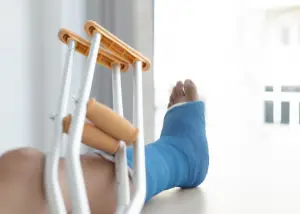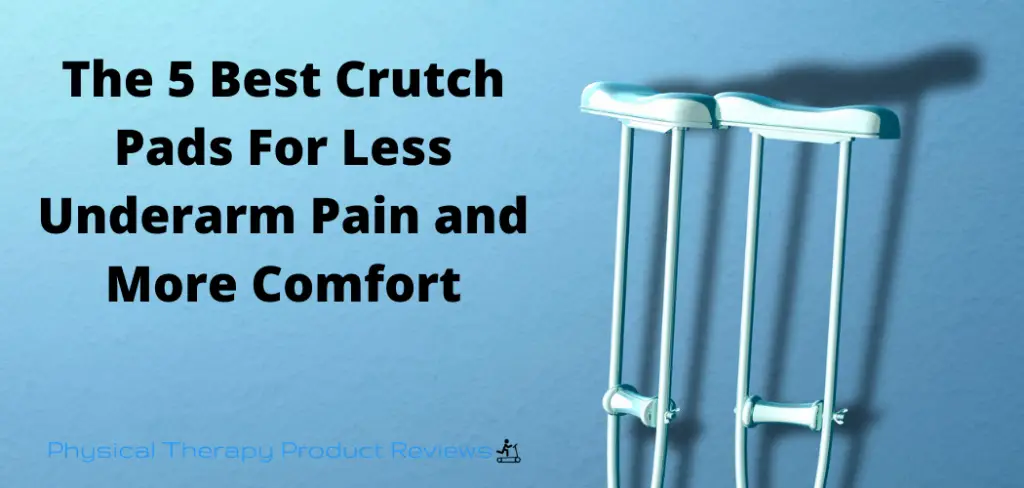Crutches are a common tool for the recovery of injuries to the leg. Most of us will at some point or another will sprain, strain, fracture, or even break a leg. During the recovery period, it is important to reduce the strain and stress in order to let your leg properly heal.
Crutches perform this job admirably, albeit stock crutches are a little uncomfortable to use for long periods of time. Crutch pads help you use your crutches in comfort, lengthening the amount of time you can stay on your feet.
Comparison Table for Crutch Pads
| Name | Picture | Price | Best Feature | Our rating | Best Price |
|---|---|---|---|---|---|
| Vive Crutch Pads |
 |
$ | Great Support for the underarms and comes in fun colors | 9.7/10 | See Current Price |
| Crutcheze Premium USA Made Crutch Pad |
 |
$ | Great cushioning, extremely comfortable | 9.7/10 | See Current Price |
| Pivit Crutch Pads |
 |
$ | Made of soft foam to create maximal comfort | 9.6/10 | See Current Price |
| Universal Crutch Underarm Pad Covers |
 |
$ | Soft fleece underarm crutch pads. We personally love the fleece option | 9.4/10 | See Current Price |
| Crosstrap Underarm Crutch Pad |
 |
$ | Comes with additional grip pads | 9.2/10 | See Current Price |
What are Crutch Pads?
 Crutch pads are padding that you can add to the end and the grips of a crutch. These pads help to alleviate the pressure placed on your body from the extra weight. Due to the structure of the shoulder, the arteries and nerves run in-between the scapula and humerus as well as an axillary nerve running through the underside of the armpit. The arm and shoulder are naturally designed to hang as free weight and swing when walking to counterbalance movement.
Crutch pads are padding that you can add to the end and the grips of a crutch. These pads help to alleviate the pressure placed on your body from the extra weight. Due to the structure of the shoulder, the arteries and nerves run in-between the scapula and humerus as well as an axillary nerve running through the underside of the armpit. The arm and shoulder are naturally designed to hang as free weight and swing when walking to counterbalance movement.
When using crutches, the pressure is directed upwards into the neurovascular bundle and places pressure on the nerves. This can lead to tingling, discomfort, pain, and numbness in the arms. Crutch pads are used to alleviate this pressure, allowing for proper blood flow, and reduces the amount of pressure in the arm by absorbing the pressure itself.
How to Use Crutches Correctly
Using crutches is pretty straightforward although it may feel a little awkward at first. Proper height of the crutch is key to prevent placing too much pressure on a nerve or reducing blood flow to the arm.
When walking with crutches:
- Proper height placement of the crutch is key, leave just a little room between the armpit and the top pad of the crutch.
- If not placing any weight on a leg, the crutches should follow the affected leg, or rather where it would normally be placed, and then hopping through with the stable leg.
- This is the same technique for an injured leg which can take partial weight.
- When walking with a single crutch, the crutch should follow the affected leg, providing a little assistance in keeping the full weight off of it.
How to Put on Crutch Pads
- The top pads for the crutch slip-on, like a pillowcase and secured with a hook and fastener.
- The handle pads are generally wrapped around the existing grip, using velcro to fasten them securely or a hook and fastener.
What are the Benefits Of Using Crutch Pads?
Crutch pads are tools that help individuals using crutches. Crutch pads often come in sets of two and can be used by either the left or right foot. They help to reduce discomfort and pressure caused by the crutches.
When you use a pair of crutches, your hand, wrist, and arm have to bear most of your body weight. Crutch pads help to reduce the amount of damage that is caused by this pressure.
Your skin can be damaged by rubbing against the crutches and pads provide a layer between your skin and the material on the crutch tips.
They also protect your hands from blisters that may form while you use a pair of crutches.

Crutch pads are particularly useful for individuals who have just begun to use crutches as the skin is sensitive and it takes time to get used to using a pair of crutches.
It also helps those who have been using the same pair of crutches for a long period of time as their hands may be callused and thick-skinned from having to constantly use the same pair of crutches.
Crutch pads are designed in such a way that they are made for either your left or right foot so you don’t have to worry about having the wrong ones. They are usually sold in pairs so that you can use one on each foot, though some people prefer to buy two of the same color and just flip them over. However they are purchased, crutch pads provide many benefits while using a pair of crutches to help individuals become more comfortable.
Why Should I use Crutch Pads?
Crutch pads are used to prevent calluses, blisters, and another discomfort that may be caused by the tips of a pair of crutches digging into your skin.
Crutch pads can be most helpful for individuals who have been using crutches for a long time and suffer from skin issues that are caused by the use of crutches. Crutch tips are usually made of metal or hard plastic while crutch pads are designed to be soft and comfortable to wear so they absorb most, if not all, of the pressure that is applied to them while being used on a regular basis.
Using crutch pads may also be helpful in preventing some skin conditions, such as P.K.C caused by using crutches for an extended period of time and the pressure applied to the tips of your crutches.

Which Material is the Best for Crutch Pads?
Crutch pads can be made of many different materials. Some common ones are leather, neoprene, fabric/cotton, and rubber. Each material is known to have its own pros and cons.
Leather Crutch Tips
Leather crutch tips are popular for being long-lasting and very easy to maintain over time. They help to prevent calluses and blisters from occurring while using a pair of crutches. However, they are not as comfortable to wear as some other materials for crutch pads may be.
Neoprene Crutch Tips
Neoprene is a type of material that is used often in the medical industry due to its ability to absorb shock. It is soft and most people find it to be more comfortable than some other materials, such as leather. It is easy to clean and maintain also.
Fabric/Cotton Crutch Tips
Fabric or cotton crutch tips are made from a mix of material that is usually found in clothing. They tend to hold up well over time and provide comfort while being worn while using crutches. However, the material may be less durable than some other materials and can cause issues when they get wet.
Rubber Crutch Tips
Rubber or silicone are both great for providing traction to a pair of crutches while being worn by an individual who is using them. They are also easy to clean and maintain over time. However, these crutch pads tend to be less comfortable than other materials and may cause issues when they get wet.
How Should I Clean the Crutch Pads?
It is important to keep the crutch pads clean so they continue working properly and last you for as long as possible. A simple solution of soap and water works great in most conditions.
It’s recommended not to use too much water or soap when cleaning your crutches pads as it can cause them to wear out faster.
Another option is to take them off your crutches and spray them lightly with a mist of water in a sink then wipe off all the residue liked with a damp cloth or paper towel. Neoprene crutch pads should be cleaned by wiping them gently with a damp cloth that has been lightly sprayed with water.
How Should I Clean the Crutch Pads?
It is important to keep the crutch pads clean so they continue working properly and last you for as long as possible. A simple solution of soap and water works great in most conditions.
It’s recommended not to use too much water or soap when cleaning your crutches pads as it can cause them to wear out faster.
Another option is to take them off your crutches and spray them lightly with a mist of water in a sink then wipe off all the residue liked with a damp cloth or paper towel. Neoprene crutch pads should be cleaned by wiping them gently with a damp cloth that has been lightly sprayed with water.
What Thickness of Padding Should I Choose for Crutch Pads?
When choosing a crutch pad that is right for the individual using it, thickness is usually one of the biggest things to take into consideration.
It’s recommended to measure your wrists if you are unsure what size to get. There are also different types of thicknesses available, such as ¼” thick pads or ½” thick pads.
Also, some crutch pads may be made of different thicknesses, such as ¼” on top and ½” on the bottom handle.
How Tall Should My Crutches Be?
Crutches that are too short or tall for an individual may cause issues when walking while using them. Having the right size crutches can help to prevent a number of issues and make it easier to use a pair of crutches more often.
The easiest way to know what height the crutches should be is a 2-finger width distance from your armpit to the top of the crutches when you are standing.
The crutch handle height should be at the same level as the crease in your wrist when your arms are hanging straight down.
How do you Adjust the Crutch Height?
Crutch height can be adjusted to many different heights by using the button on your crutches that releases the pin or retainer.
Most crutches will travel a few inches shorter than the full length, making it easier for walking and not having to use so much energy while on them.
The handles typically have 2 wing nuts that you can unscrew and adjust the height of hand grip. The hand grip shoulder hit at the crease of the wrist when standing.
The Best Crutch Pads for Less Underarm Pain
Vive Crutch Pads
Summary: The Vive Crutch Pads are simple foam slip-on pads. These crutch pads are breathable and easy to install and come in a variety of different colors which make them fun to use after any injury. These do come with a 60 day guarantee.
Pros: Vive offered a 60-day guarantee with this product. Also, the handgrips are made with leather to ensure a strong grip.
Cons: The breathable covering of the foam is a very soft material, meaning that they may not take the wear and tear very well over time.
Crutcheze Premium USA Made Crutch Pad
Summary: The Crutcheze crutch pads were originally designed and manufactured by a nurse for an ailing friend. Since then, after consulting with many medical professionals and patients, these pads have been designed for maximum comfort and utility.
Pros: The covering of these pads is made with Bodycare fabric, which has strong antibacterial properties. The foam core of these pads is also made with medical-grade materials, providing a high degree of relief.
Cons: The hand grips of these pads are also covered in Bodycare fabric. Which can be slippery and cause a patient to lose their grip.
Pivit Crutch Pad
Summary: The Pivit crutch pads are made with moisture-wicking fabric, designed to keep your armpits dry and prevent chafing. The material itself is also machine washable.
Pros: These pads offer maximum relief, having many patients describing relief from soreness after their use with crutches. The type of fabric that these pads are made with reduces wear and tear on clothing, providing your favorite shirts a little relief too.
Cons: The foam core of these pads have a tendency to wear out quickly.
Universal Crutch Underarm Pad Covers
Summary: The Universal Underarm Crutch Pads are made from memory foam and fleece, Ensuring a high degree of comfort.
Pros: The memory foam and fleece combination are very comfortable, providing a high degree of relief from the stock crutch pad. Also, these pads are fairly affordable for those patients who may be on a budget or off work to recover.
Cons: The only downside of these crutch pads is that if you are needing handgrips, then they must be purchased separately.
Underarm Crutch Pad and Hand Grip
Summary: The Cross strap Underarm Crutch pads are designed by MDUB Medical for the maximum orthopedic relief. They are moisture-wicking, shaped foam pads, that are washable and breathable.
Pros: MDUB Medical really wanted to create a product that patients could use all day without having to deal with being over sweaty from use. The moisture-wicking properties of the pads also limit bacterial growth and can easily be tossed into a washing machine to clean.
Cons: Some have complained about the amount of cushion in the pads as compared to other models
Conclusion:
Crutches are an integral part of recovery when dealing with a sprained ankle, broken toe, or otherwise injured leg. While traditional crutches are often uncomfortable to use over a long time, they don’t have to be when a patient includes the use of crutch pads. There is no reason a patient should heal in discomfort.
Works Cited:
Other Great Rehab Related Articles
How to Stay Active After Cervical Fractures: Expert Tips and Advice
Dealing with Painful Stairs After Ankle Replacement Surgery
Walking After a Total Ankle Replacement: Tips for a Successful Recovery
Exercises While Non-Weight Bearing After Ankle Replacement: Elevation, AROM, Leg Raises, and More
Ankle Pain with Stairs: Causes and Home Treatment Options
5 Common Mistakes You’re Making After an Ankle Sprain
Disclaimer: The information provided in this post is for educational purposes only. This is not a substitute for a medical appointment. Please refer to your physician before starting any exercise program.











